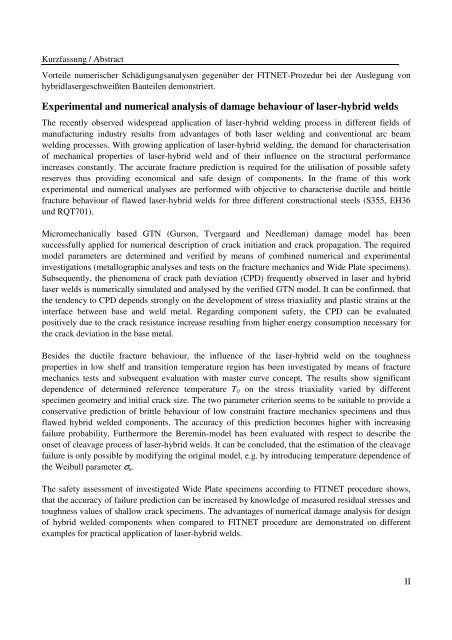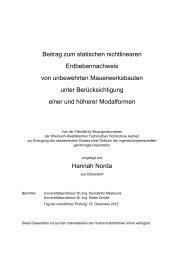Dokument 1.pdf (35.736 KB) - RWTH Aachen University
Dokument 1.pdf (35.736 KB) - RWTH Aachen University
Dokument 1.pdf (35.736 KB) - RWTH Aachen University
Erfolgreiche ePaper selbst erstellen
Machen Sie aus Ihren PDF Publikationen ein blätterbares Flipbook mit unserer einzigartigen Google optimierten e-Paper Software.
Kurzfassung / Abstract<br />
Vorteile numerischer Schädigungsanalysen gegenüber der FITNET-Prozedur bei der Auslegung von<br />
hybridlasergeschweißten Bauteilen demonstriert.<br />
Experimental and numerical analysis of damage behaviour of laser-hybrid welds<br />
The recently observed widespread application of laser-hybrid welding process in different fields of<br />
manufacturing industry results from advantages of both laser welding and conventional arc beam<br />
welding processes. With growing application of laser-hybrid welding, the demand for characterisation<br />
of mechanical properties of laser-hybrid weld and of their influence on the structural performance<br />
increases constantly. The accurate fracture prediction is required for the utilisation of possible safety<br />
reserves thus providing economical and safe design of components. In the frame of this work<br />
experimental and numerical analyses are performed with objective to characterise ductile and brittle<br />
fracture behaviour of flawed laser-hybrid welds for three different constructional steels (S355, EH36<br />
und RQT701).<br />
Micromechanically based GTN (Gurson, Tvergaard and Needleman) damage model has been<br />
successfully applied for numerical description of crack initiation and crack propagation. The required<br />
model parameters are determined and verified by means of combined numerical and experimental<br />
investigations (metallographic analyses and tests on the fracture mechanics and Wide Plate specimens).<br />
Subsequently, the phenomena of crack path deviation (CPD) frequently observed in laser and hybrid<br />
laser welds is numerically simulated and analysed by the verified GTN model. It can be confirmed, that<br />
the tendency to CPD depends strongly on the development of stress triaxiality and plastic strains at the<br />
interface between base and weld metal. Regarding component safety, the CPD can be evaluated<br />
positively due to the crack resistance increase resulting from higher energy consumption necessary for<br />
the crack deviation in the base metal.<br />
Besides the ductile fracture behaviour, the influence of the laser-hybrid weld on the toughness<br />
properties in low shelf and transition temperature region has been investigated by means of fracture<br />
mechanics tests and subsequent evaluation with master curve concept. The results show significant<br />
dependence of determined reference temperature T0 on the stress triaxiality varied by different<br />
specimen geometry and initial crack size. The two parameter criterion seems to be suitable to provide a<br />
conservative prediction of brittle behaviour of low constraint fracture mechanics specimens and thus<br />
flawed hybrid welded components. The accuracy of this prediction becomes higher with increasing<br />
failure probability. Furthermore the Beremin-model has been evaluated with respect to describe the<br />
onset of cleavage process of laser-hybrid welds. It can be concluded, that the estimation of the cleavage<br />
failure is only possible by modifying the original model, e.g. by introducing temperature dependence of<br />
the Weibull parameter σu.<br />
The safety assessment of investigated Wide Plate specimens according to FITNET procedure shows,<br />
that the accuracy of failure prediction can be increased by knowledge of measured residual stresses and<br />
toughness values of shallow crack specimens. The advantages of numerical damage analysis for design<br />
of hybrid welded components when compared to FITNET procedure are demonstrated on different<br />
examples for practical application of laser-hybrid welds.<br />
II
















